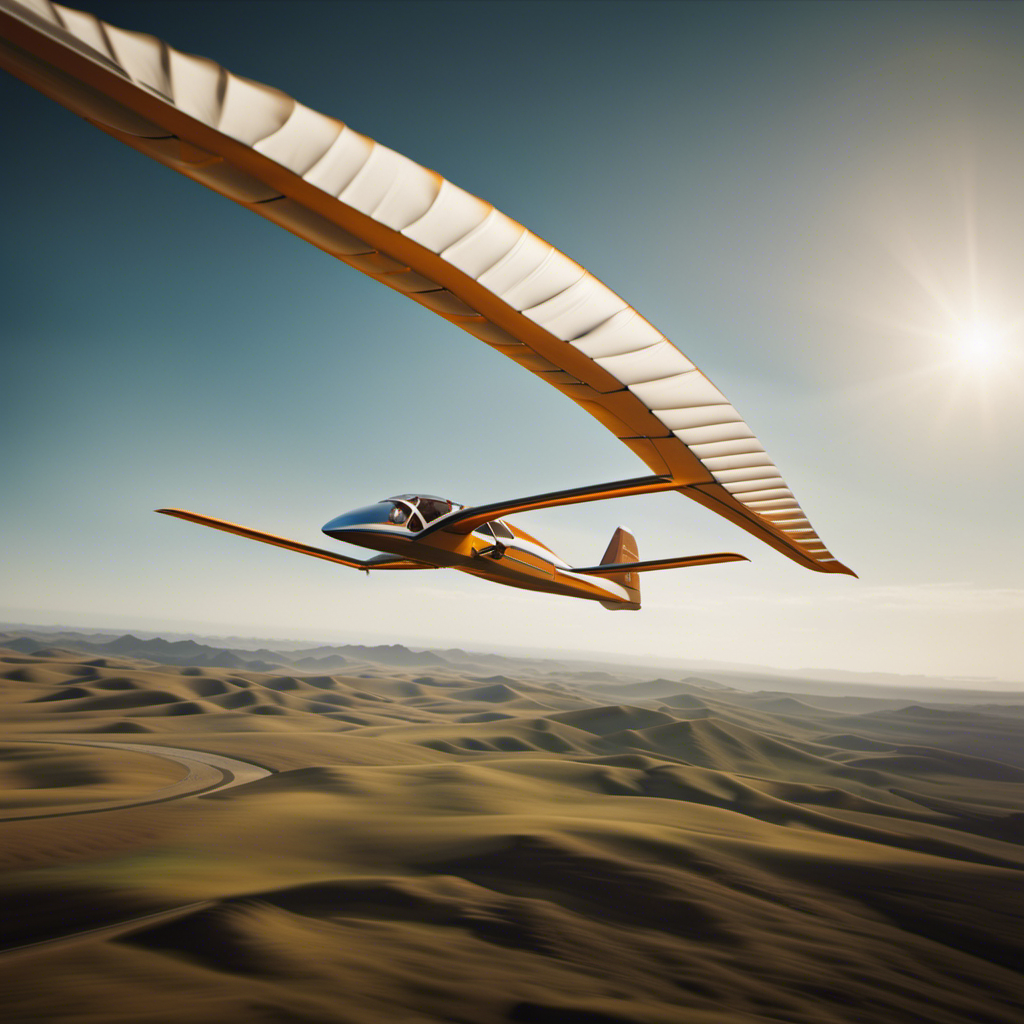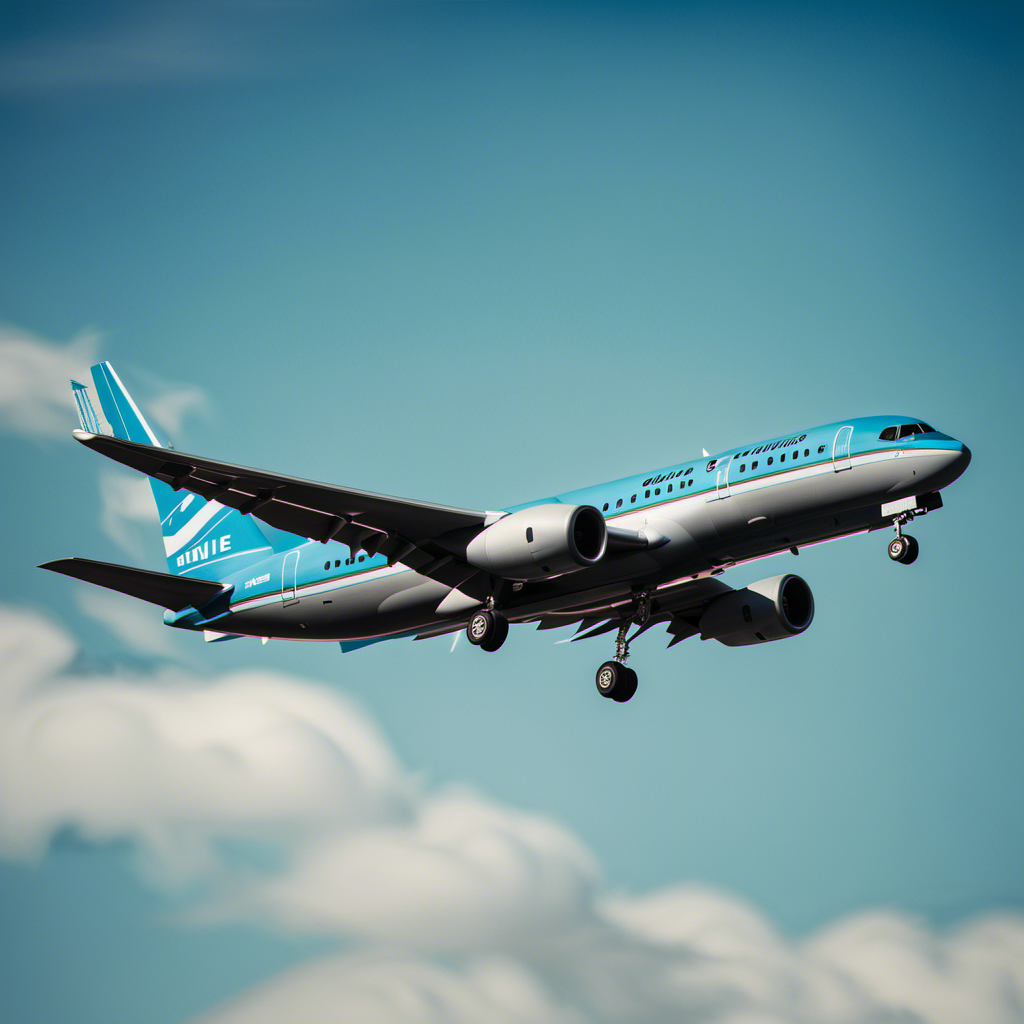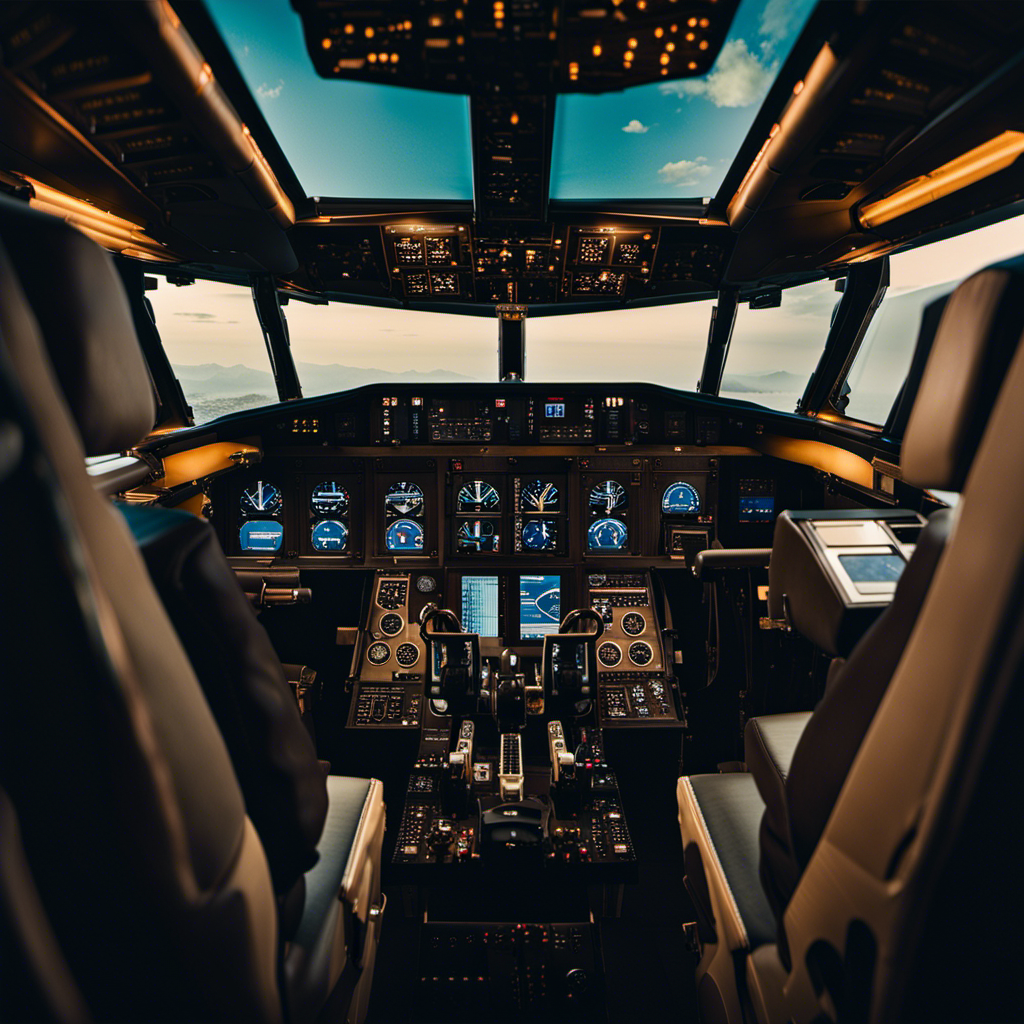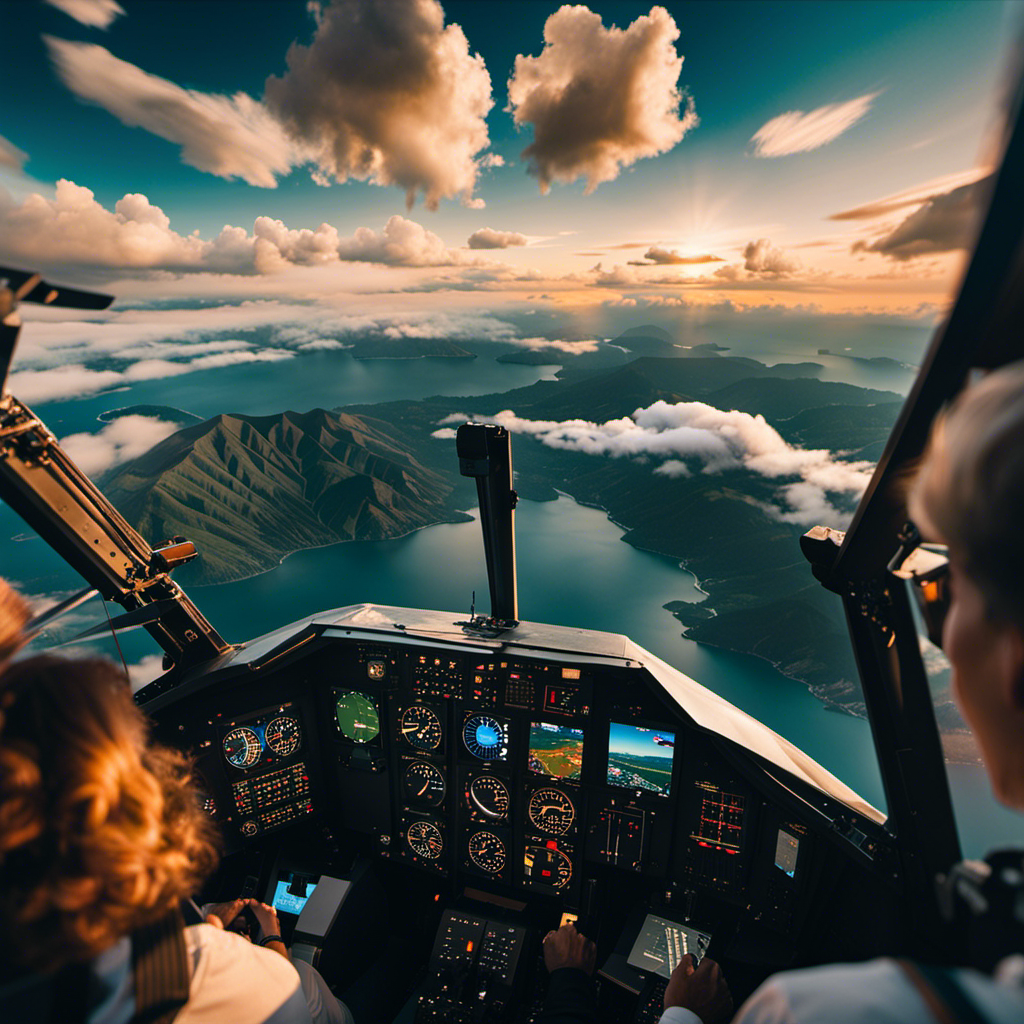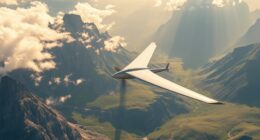As a glider pilot, I have always been fascinated by the intricate mechanics of glider wings. The juxtaposition of their simple design with their ability to defy gravity is truly astounding.
In this article, we will delve into the technicalities of how glider wings work, exploring the principles of lift and aerodynamics, the materials and design that optimize performance, and the control surfaces that allow for maneuverability.
Join me on this journey as we unravel the mysteries behind these remarkable flying machines.
Key Takeaways
- The choice of wing configuration, such as high-wing, low-wing, or mid-wing, directly affects the overall performance of a glider.
- The glide ratio and L/D ratio play a crucial role in determining the efficiency of a glider’s wings, with factors like wing design, aspect ratio, and airfoil shape optimizing these ratios.
- The stall speed is the minimum airspeed required to maintain lift and prevent stalling, while the maximum speed is the highest airspeed without risking structural damage. Balancing these speeds is essential for optimizing glide performance and distance covered.
- Thermals, which are rising warm air columns, provide lift for gliders and allow them to gain altitude and extend flight time. Skill and experience are required to efficiently use thermals for gliding.
The Basics of Glider Wings
Glider wings create lift by taking advantage of the air flowing over them. The design of glider wings plays a crucial role in achieving optimal wing loading and performance.
Wing loading refers to the weight of the glider divided by the wing area. A lower wing loading allows for a better glide ratio and improved performance.
To enhance the efficiency of glider wings, various techniques are employed to reduce drag. These include using airfoil shapes that minimize drag, employing winglets to reduce induced drag, and optimizing the wing surface to reduce skin friction. By reducing drag, glider wings can achieve higher speeds and better overall performance.
Understanding the relationship between wing loading, efficiency, and drag reduction is essential in maximizing the capabilities of glider wings.
Moving on to the next section, let’s explore the principles of lift and aerodynamics.
Lift and Aerodynamics
When discussing lift and aerodynamics, two key points to consider are Bernoulli’s Principle and the Coanda Effect.
Bernoulli’s Principle explains how the difference in air pressure above and below a wing creates lift, while the Coanda Effect describes how a moving fluid, such as air, adheres to a curved surface.
Additionally, wing shape and angle of attack play a crucial role in determining lift. The shape of the wing, particularly its curvature or camber, affects the airflow and generates lift, while the angle of attack, which is the angle between the wing’s chord line and the oncoming airflow, determines the efficiency of lift production.
Bernoulli’s Principle and Coanda Effect
The Coanda effect explains how wings create lift by altering the airflow around them. When air flows over the curved upper surface of a wing, it speeds up, causing a decrease in pressure according to Bernoulli’s principle. This pressure difference between the upper and lower surfaces of the wing generates lift.
The application of Bernoulli’s principle in wing design is crucial for optimizing glider performance. By carefully shaping the wings, engineers can manipulate the airflow to maximize lift and minimize drag. The shape and angle of attack of the wing directly impact the glider’s ability to generate lift and control its flight.
As we transition into the next section about wing shape and angle of attack, it is important to understand how these factors contribute to the overall performance of a glider.
Wing Shape and Angle of Attack
To maximize lift and control your glider’s flight, you’ll want to carefully consider the shape and angle of attack of its wings. The shape of the wing, also known as the airfoil, plays a crucial role in determining the efficiency of the glider. The angle of attack refers to the angle at which the wing meets the oncoming airflow. By adjusting the shape and angle of attack, we can manipulate the airflow and generate lift.
When it comes to glider wing manufacturing, there are various shapes and designs to choose from. To help you understand the different options available, here is a table showcasing some common wing shapes and their characteristics:
| Wing Shape | Advantages | Disadvantages |
|---|---|---|
| Rectangular | Simple design, good for slow speeds | High drag, less efficient at higher speeds |
| Elliptical | High lift, efficient at various speeds | Complex manufacturing, more expensive |
| Tapered | Reduced drag, good for high speeds | Less lift at low speeds |
| Swept | Reduced drag at high speeds, good for maneuverability | Reduced lift at low speeds |
Wing Materials and Design
Different wing materials and designs affect the performance of gliders. The choice of wing material and design plays a crucial role in determining the glider’s efficiency and maneuverability. Here are three key factors to consider:
-
Material: The choice of wing material can greatly impact the glider’s weight and strength. Lighter materials such as carbon fiber or fiberglass reduce the overall weight of the glider, allowing for better lift-to-drag ratio and improved performance. On the other hand, materials like aluminum offer increased durability and structural integrity.
-
Wing shape: The design of the wing, including its shape and aspect ratio, affects the glider’s lift and drag characteristics. A high aspect ratio wing, with a long and slender shape, provides greater lift and reduced drag, resulting in improved glide performance. Conversely, a low aspect ratio wing is better suited for faster speeds and maneuverability.
-
Wingtip design: The shape of the wingtip affects the glider’s stability and control. A wingtip with a pointed shape, known as a ‘winglet,’ reduces drag caused by wingtip vortices, thereby increasing efficiency. Alternatively, wingtips with a rounded shape offer better maneuverability and control during turns.
By carefully considering the wing materials and design, glider manufacturers can optimize the performance and handling characteristics of their aircraft.
Transitioning to the next section about control surfaces and maneuverability, the design of these surfaces directly influences the glider’s ability to change direction and perform various maneuvers.
Control Surfaces and Maneuverability
Transition: Now that we understand the importance of wing materials and design, let’s delve into the world of control surfaces and how they contribute to a glider’s maneuverability.
Current Subtopic: Control Surfaces and Maneuverability
Control surfaces are crucial components of a glider’s flight control systems, allowing pilots to manipulate the aircraft’s movement and stability. These surfaces include the ailerons, elevators, and rudder, each designed to perform specific functions during flight. To better understand their roles, let’s take a look at the table below:
| Control Surface | Function |
|---|---|
| Ailerons | Control roll and lateral movement |
| Elevators | Control pitch and longitudinal movement |
| Rudder | Control yaw and directional stability |
Through careful control surface design, pilots can adjust the lift and drag forces acting on the glider, enabling precise maneuvering and responsive handling. These control surfaces, combined with the wing’s aerodynamic properties, form the foundation for a glider’s flight characteristics.
Transition: Now that we have explored control surfaces and their role in maneuverability, let’s continue our journey by examining glider wing configurations.
Glider Wing Configurations
When considering glider wing configurations, you’ll find that there are several different types to choose from. The stability and efficiency of a glider’s wings are crucial factors in its performance.
One popular configuration is the high-wing design, where the wings are mounted on the top of the fuselage. This configuration provides excellent stability and is commonly found in training gliders.
Another configuration is the low-wing design, with the wings mounted on the bottom of the fuselage. This design offers better efficiency and is often seen in high-performance gliders.
Lastly, there is the mid-wing configuration, which strikes a balance between stability and efficiency.
Transitioning into the section on glider wing performance, it’s important to note that the choice of wing configuration directly affects the overall performance of the glider.
Glider Wing Performance
When discussing the performance of glider wings, there are several key points to consider.
Firstly, the glide ratio and L/D ratio play a crucial role in determining the efficiency of a glider’s wings. These ratios indicate how far a glider can travel horizontally for each unit of vertical descent and are often used to compare the performance of different glider designs.
Secondly, the stall speed is an important factor as it determines the minimum speed at which a glider can maintain lift and avoid stalling.
Lastly, the maximum speed of a glider is another significant parameter that affects its overall performance and handling characteristics.
Glide Ratio and L/D Ratio
The glide ratio and L/D ratio determine the efficiency of glider wings. The glide ratio is the distance a glider can travel horizontally for every unit of altitude lost. It is calculated by dividing the forward distance traveled by the altitude lost. A higher glide ratio indicates a more efficient glider.
To optimize the glide ratio, factors like wing design, aspect ratio, and airfoil shape are considered. The L/D ratio, or lift-to-drag ratio, is another measure of efficiency. It represents the amount of lift generated by the wings compared to the amount of drag produced. The impact of weight on the L/D ratio is significant, as heavier gliders tend to have lower L/D ratios.
Maximizing the L/D ratio is crucial for glider performance and endurance.
Now, let’s explore the relationship between stall speed and maximum speed.
Stall Speed and Maximum Speed
As we explored the concept of glide ratio and L/D ratio, it became clear that understanding the aerodynamics of glider wings is crucial for efficient flight.
Now, let’s delve into two key performance parameters: stall speed and maximum speed.
Stall speed refers to the minimum airspeed necessary to maintain lift and prevent the aircraft from stalling. It is affected by various factors such as weight, wing shape, and wing loading.
On the other hand, maximum speed is the highest airspeed at which the glider can safely operate without risking structural damage.
To optimize glide performance, pilots must find the balance between these two speeds. By maintaining a speed slightly higher than stall speed, but below the maximum speed, the glider can achieve its best glide ratio and cover the greatest horizontal distance.
Now, let’s explore the fascinating world of thermals and soaring, where gliders can gain altitude without the need for an engine.
Thermals and Soaring
To maximize your glider’s altitude, you’ll need to take advantage of thermals and soar using the wings.
Thermals are columns of rising warm air that can provide lift for the glider. When flying through a thermal, the glider’s wings are angled to maximize lift and minimize drag. This is achieved by adjusting the control surfaces, such as the ailerons and flaps, to optimize glider wing efficiency.
By finding and staying within thermals, the glider can gain altitude and extend its flight time. However, it is important to note that flying in thermals requires skill and experience, as it involves reading the air currents and making precise adjustments to maintain flight.
Safety and maintenance of glider wings play a critical role in ensuring the longevity and performance of the aircraft.
Safety and Maintenance of Glider Wings
Regular inspections and maintenance are crucial for keeping glider wings in optimal condition. Safety procedures should be followed meticulously to ensure the safety of both the pilot and the glider.
Before every flight, I perform a thorough inspection of the wings, checking for any signs of damage or wear. This includes examining the wing structure, inspecting the control surfaces, and checking the attachment points.
Wing maintenance also involves cleaning the wings, removing any dirt or debris that could affect the aerodynamics. Additionally, regular lubrication of the control mechanisms is essential to ensure smooth and precise operation.
By adhering to these safety procedures and performing regular maintenance, I can trust that my glider wings are in top-notch condition, ready for the next soaring adventure.
With advances in glider wing technology, these maintenance tasks have become more streamlined and efficient, allowing for even better performance and safety.
Advances in Glider Wing Technology
With advances in glider wing technology, maintenance tasks have become more streamlined and efficient, allowing for even better performance and safety. These advancements have revolutionized the way we maintain and optimize glider wings.
Here are some key features of the latest glider wing technology:
- Improved aerodynamics: New wing designs reduce drag and enhance lift, resulting in improved efficiency and longer flight times.
- Lightweight materials: Advanced composite materials make glider wings lighter without compromising strength, leading to increased fuel efficiency and maneuverability.
- Automated inspection systems: High-resolution cameras and sensors detect any structural issues or damage, enabling prompt maintenance and reducing downtime.
- Smart wing technology: Integrated sensors and computer systems continuously monitor wing performance, allowing for real-time adjustments that optimize efficiency and safety.
These advancements in glider wing technology have greatly improved the efficiency and effectiveness of maintenance tasks.
Looking ahead, the future of glider wings holds even more exciting possibilities for increased performance and safety.
Future of Glider Wings
In the future, glider wings will be equipped with advanced technology to enhance performance and safety. Future advancements in glider wing technology will focus on incorporating sustainable materials and design features to reduce environmental impact and increase efficiency. One such advancement is the use of lightweight composite materials, such as carbon fiber, in the construction of glider wings. These materials offer high strength-to-weight ratios, allowing for stronger and more durable wings that are also lighter, resulting in improved fuel efficiency and longer flight times. Additionally, glider wings of the future will be equipped with smart sensors and actuators that can automatically adjust wing shape and control surfaces based on real-time flight conditions, optimizing aerodynamic performance and enhancing safety. These advancements in glider wing technology highlight the industry’s commitment to sustainability efforts and improving the overall efficiency of glider flight.
| Future Advancements | Sustainability Efforts |
|---|---|
| Lightweight Composite Materials | Reduce Environmental Impact |
| Smart Sensors and Actuators | Increase Efficiency |
Frequently Asked Questions
What are some common safety measures that glider pilots should take when operating glider wings?
As a glider pilot, I understand the importance of glider wing safety measures. Regular inspections of the wings are crucial to ensuring their structural integrity and identifying any potential issues that could compromise flight safety.
How often do glider wings need to be maintained and what are some common maintenance tasks?
Maintaining glider wings is crucial for safe and efficient flight. The frequency of maintenance depends on usage and regulations. Common tasks include inspecting for damage, cleaning, lubricating control surfaces, and ensuring proper tension and alignment of the wings.
Are there any specific regulations or guidelines that govern the design and construction of glider wings?
Yes, there are specific regulations and guidelines that govern the design and construction of glider wings. These regulations ensure safety measures, performance, and efficiency. Maintenance tasks, modifications, and customization must also adhere to these guidelines. Advancements in technology continue to improve glider wing design.
Can glider wings be modified or customized to suit individual pilot preferences or flying conditions?
Yes, glider wings can be modified and customized to suit individual pilot preferences and flying conditions. Glider wing modifications include changes to wing shape, size, and control surfaces, allowing for improved performance and handling characteristics. Customization options for glider wings vary depending on the specific glider model and manufacturer.
What are some recent advancements in glider wing technology that have improved performance and efficiency?
Recent advancements in glider wing technology have greatly improved performance and efficiency. New materials such as carbon fiber composites and innovative wing designs, like the use of winglets, have reduced drag and increased lift, resulting in better gliding capabilities.
Conclusion
In conclusion, glider wings are a marvel of engineering. The intricate design and materials used allow for maximum lift and maneuverability. It is truly fascinating to see how these wings harness the power of thermals to soar through the sky.
While safety and maintenance are crucial, advances in technology continue to push the boundaries of glider wing capabilities. Who would have thought that such a seemingly simple structure could hold so much potential?
The future of glider wings is bound to be filled with even more awe-inspiring developments.
With a heart that soars as high as the skies, Aria, affectionately known as “Skylark,” is the driving force behind Soaring Skyways. Her journey into the gliding world began as a young dreamer gazing up at the soaring birds, yearning to experience the weightlessness and freedom they embodied. With years of experience both in the cockpit and behind the scenes, Aria’s commitment to the gliding community is unwavering.
